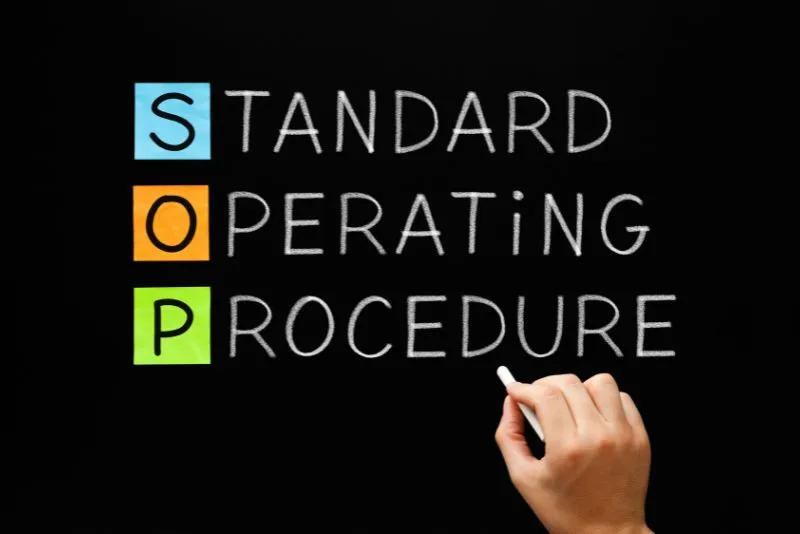Why Standard Operating Procedures Are a Must-Have for Every Business

Standard Operating Procedures, or SOPs are systematic and detailed documents that outline the step-by-step processes and procedures necessary to perform a specific task or function within an organization.
Why use SOPs?
SOPs act as a roadmap, guiding employees through routine tasks, complex procedures, or critical operations. They are responsible for maintaining consistency, quality, and compliance in a business setting.
- Operational Efficiency: By streamlining processes and reducing errors, SOPs boost operational efficiency. They save time, resources, and costs, allowing businesses to allocate their resources more effectively.
- Training and Onboarding: SOPs facilitate the training and onboarding of new employees, reducing the learning curve and ensuring that newcomers quickly become productive contributors to the organization.
- Compliance and Risk Mitigation: SOPs help businesses adhere to industry regulations and standards, reducing the risk of non-compliance and potential legal issues. They also serve as a risk management tool by outlining procedures for handling emergencies and unforeseen situations.
- Knowledge Retention: SOPs capture and preserve institutional knowledge, ensuring that best practices and expertise are retained within the organization. This knowledge can be shared and passed down to future generations of employees.
- Continuous Improvement: SOPs are dynamic documents that can be updated and improved over time. They provide a framework for ongoing process refinement and innovation, fostering a culture of continuous improvement within the organization.
- Data-Driven Decision-Making: SOPs often include data collection and reporting procedures. This enables businesses to gather valuable insights, make informed decisions, and drive strategic growth.
- Competitive Advantage: Businesses with well-established SOPs are better positioned to adapt to dynamic market conditions and seize opportunities. The agility and efficiency gained through SOPs can provide a significant competitive advantage.
Why Do Businesses Need SOPs?
SOPs are versatile tools that can be applied to various aspects of a business, from manufacturing and customer service to administrative processes. Here are some crucial areas where SOPs are essential:
- Manufacturing and Production
In manufacturing industries, precision and consistency are critical. SOPs provide a detailed guide on how to set up, operate, and maintain machinery, ensuring that products meet the desired quality standards. They also cover safety procedures to protect both employees and equipment.
- Customer Service
For businesses providing customer support, SOPs define the protocols for addressing customer inquiries, resolving complaints, and maintaining a high level of customer satisfaction. They help ensure that each customer receives consistent and efficient service.
- Administrative Tasks
Even in administrative functions, SOPs are invaluable. They streamline processes such as document management, data entry, and procurement. By following these procedures, employees can avoid inefficiencies and errors in day-to-day tasks.
- Health and Safety
In workplaces, prioritizing the health and safety of employees is crucial. SOPs lay out safety protocols, emergency procedures, and guidelines for the proper use of safety equipment, reducing the risk of accidents and injuries.
What Are the Different Components of an SOP?
To ensure clarity, effectiveness, and ease of use, SOPs are typically divided into several key components, each serving a distinct purpose.
- Title and Purpose: The Title and Purpose section serves as the introduction to the SOP. It should feature a clear and concise title that accurately reflects the content and scope of the procedure. Additionally, a brief statement of purpose outlines why this SOP is necessary and what it aims to achieve.
- Scope: Defining the scope is crucial to set the boundaries of the procedure. In this section, you specify the specific task, process, or activity covered by the SOP. This helps readers understand what falls within the scope of the document and what doesn’t.
- Responsibilities: This part identifies the roles and responsibilities of individuals or positions involved in the process. Clearly define who is responsible for each step, making it easier to assign tasks and ensure accountability. For complex processes involving multiple stakeholders, a clear delineation of responsibilities is essential.
- Procedure: The Procedure section forms the core of the SOP. It provides a step-by-step breakdown of the process, detailing each action or task required to complete it. To enhance clarity and comprehension, use straightforward language, avoid jargon, and be as specific as possible. The procedure should be presented in a logical and sequential order, ensuring that readers can follow it easily.
- References: In some cases, SOPs may require additional context or information for users. In the References section, you can include any relevant documents, regulations, standards, or resources that individuals might need while executing the procedure. This can include links to external documents, references to internal policies, or citations of industry standards.
- Revision History: To maintain the integrity of the SOP over time, it’s essential to keep track of changes and revisions. The Revision History section logs the date of each revision, the name of the person who made the changes, a brief description of the modifications, and the version number. This historical record ensures that all users are working with the most up-to-date version of the SOP.
What Are the Best Practices for SOPs?
To create an effective Standard Operating Procedure (SOP), it’s crucial to adhere to these best practices. By following these guidelines, you can ensure that your SOPs are clear, user-friendly, and capable of guiding employees through various processes and tasks:
- Clarity and Simplicity:
- Use plain and straightforward language. Avoid technical jargon, acronyms, or terminology that may be unfamiliar to the intended audience.
- Keep sentences concise and easy to understand. Use active voice and action verbs to describe steps.
- Logical Organization:
- Arrange the content in a logical and sequential order. Ensure that the steps follow a natural progression.
- Use headings, subheadings, and numbering to make the document easy to navigate.
- Visual Aids:
- Incorporate visual aids such as flowcharts, diagrams, images, or tables to enhance understanding, especially for complex procedures.
- Ensure that visual elements are clear and easy to interpret.
- Consistent Formatting:
- Maintain a consistent formatting style throughout the SOP, including font, font size, headings, and margins.
- Use a standard template if available to maintain uniformity across all SOPs in your organization.
- Responsibility Assignment:
- Clearly define and assign responsibilities for each step of the procedure. Specify who is accountable for what.
- Include contact information or roles for individuals involved in the process.
- Version Control:
- Implement a robust version control system to track changes and revisions to the SOP. Ensure that users always have access to the most up-to-date version.
- Use a standardized method for naming and dating versions.
- Training and Familiarization:
- Train employees on how to use and follow the SOPs. Ensure that they know where to access the latest versions.
- Encourage questions and feedback to address any uncertainties or ambiguities.
- Approval and Sign-off:
- Establish a formal approval process that involves relevant stakeholders or subject matter experts. Require signatures or acknowledgments to indicate approval.
- Keep a record of approvals and reviews.
- Regular Review and Updates:
- Schedule periodic reviews of SOPs to ensure they remain relevant and accurate. Changes in processes, regulations, or best practices may necessitate updates.
- Assign responsibility for maintaining and updating each SOP.
- Cross-Referencing and References:
- Use cross-references within the SOP to link related procedures or documents. This can help users find additional information when needed.
- Include a References section that lists external documents, regulations, or internal policies relevant to the procedure.
- Accessibility and Distribution:
- Maintain a central repository for all SOPs, making them easily accessible to the relevant personnel. This can be a physical or digital location.
- Develop a system for notifying users of updates or changes to SOPs.
- Documentation of Deviations:
- Include a section that addresses how to handle deviations or unexpected situations during the procedure.
- Describe the steps to be taken when a deviation occurs and how it should be documented and reported.
Why Should Businesses opt for SOP Services?
Businesses today face ever-increasing complexities in their operations, making the adoption of SOP services a strategic choice. Here are some of the other reasons why business should opt for SOP services:
- Regulatory Compliance Assurance: SOP services can help businesses navigate complex regulatory landscapes. They ensure that processes are aligned with industry-specific regulations and standards, reducing the risk of non-compliance and potential legal issues.
- Enhanced Employee Engagement: Well-documented SOPs can boost employee morale by providing clear guidelines for tasks and expectations. This leads to a more engaged workforce that feels confident in their roles, which can improve overall productivity and job satisfaction.
- Competitive Advantage: Businesses that invest in SOP services are better positioned to outperform competitors who lack standardized procedures. It demonstrates a commitment to excellence and can be a unique selling point in the market.
- Improved Customer Experience: Standardized processes can lead to quicker response times and more efficient customer service. This, in turn, enhances the overall customer experience and can result in increased loyalty and referrals.
- Data-Driven Decision Making: SOPs often involve data collection and reporting procedures. This data can be leveraged for informed decision-making, enabling businesses to identify trends, optimize processes, and stay competitive in their industry.
In conclusion, Standard Operating Procedures (SOPs) are not merely documents; they are valuable assets that can significantly enhance the efficiency, consistency, and overall performance of businesses across diverse industries. BSMART has an in-house team of professional writers who can create the best SOPs for your business. To know more about their services, get in touch with BSMART today.






